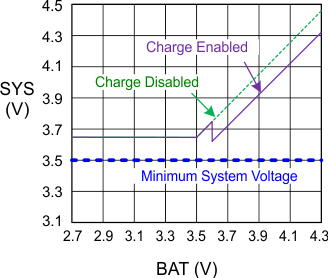SLUSBP6D september 2013 – april 2023 BQ24296 , BQ24297
PRODUCTION DATA
- 1 Features
- 2 Applications
- 3 Description
- 4 Revision History
- 5 Description (continued)
- 6 Device Comparison Table
- 7 Pin Configuration and Functions
- 8 Specifications
-
9 Detailed Description
- 9.1 Overview
- 9.2 Functional Block Diagram
- 9.3
Feature Description
- 9.3.1 Device Power Up
- 9.3.2 Power Path Management
- 9.3.3 Battery Charging Management
- 9.3.4 Status Outputs ( PG, STAT, and INT)
- 9.3.5 Protections
- 9.4 Device Functional Modes
- 9.5 Programming
- 9.6
Register Map
- 9.6.1
I2C Registers
- 9.6.1.1 Input Source Control Register REG00 [reset = 00110xxx, or 3x]
- 9.6.1.2 Power-On Configuration Register REG01 [reset = 00011011, or 0x1B]
- 9.6.1.3 Charge Current Control Register REG02 [reset = 01100000, or 60]
- 9.6.1.4 Pre-Charge/Termination Current Control Register REG03 [reset = 00010001, or 0x11]
- 9.6.1.5 Charge Voltage Control Register REG04 [reset = 10110010, or 0xB2]
- 9.6.1.6 Charge Termination/Timer Control Register REG05 [reset = 10011010, or 0x9A]
- 9.6.1.7 Boost Voltage/Thermal Regulation Control Register REG06 [reset = 01110011, or 0x73]
- 9.6.1.8 Misc Operation Control Register REG07 [reset = 01001011, or 4B]
- 9.6.1.9 System Status Register REG08
- 9.6.1.10 New Fault Register REG09
- 9.6.1.11 Vender / Part / Revision Status Register REG0A
- 9.6.1
I2C Registers
- 10Application and Implementation
- 11Power Supply Recommendations
- 12Layout
- 13Device and Documentation Support
- 14Mechanical, Packaging, and Orderable Information
Package Options
Mechanical Data (Package|Pins)
- RGE|24
Thermal pad, mechanical data (Package|Pins)
- RGE|24
Orderable Information
9.3.2.1 Narrow VDC Architecture
The device deploys Narrow VDC architecture (NVDC) with BATFET separating system from battery. The minimum system voltage is set by REG01[3:1]. Even with a fully depleted battery, the system is regulated above the minimum system voltage (default 3.5 V).
When the battery is below minimum system voltage setting, the BATFET operates in linear mode (LDO mode), and the system is 150 mV above the minimum system voltage setting. As the battery voltage rises above the minimum system voltage, BATFET is fully on and the voltage difference between the system and battery is the VDS of BATFET.
When the battery charging is disabled or terminated, the system is always regulated at 150 mV above the minimum system voltage setting. The status register REG08[0] goes high when the system is in minimum system voltage regulation.
 Figure 9-3 V(SYS) vs V(BAT)
Figure 9-3 V(SYS) vs V(BAT)